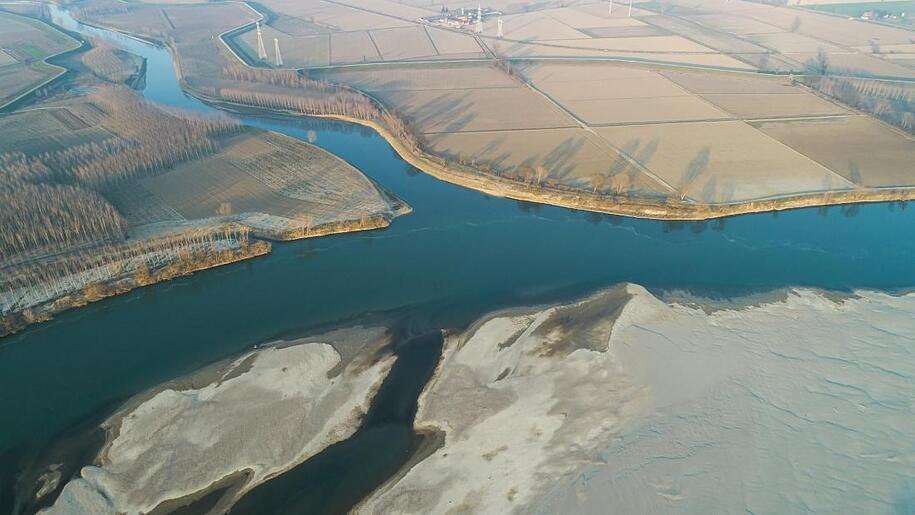Agricultural fields are abundant along Italy's river Po.
The Italian river Po travels 403 miles from the Alps to the wilds of the Po river delta in the East, where it finally empties into the Adriatic Sea. Along the way, the water nourishes the agricultural fields that Italians have farmed for thousands of years. Today, the agricultural products it grows provides 40% of the nation’s GDP.
Euro News reports that currently, a drought so severe that it threatens the breadbasket of Italy has dried up the Po River so severely that seawater has been able to be ‘sucked back upstream.’ The reason is that the water in the delta is “higher than upstream. This is because the vacuum left by the lack of river water is being filled by seawater,” Giancarlo Mantovani, the Director of a consortium that protects the delta’s biodiversity, which can be seen flowing back upstream in some areas. For farmers in the area, it means saltwater seeping into the earth and poisoning crops, which are blackened and wilting.”
There has been no rain for three months and counting, but the source of the problem starts in the Alps, where snowfall is now at its lowest level in over twenty years, measuring fifty percent lower than average. It is not only reduced snowfall, but the Alp’s glaciers which are the reservoirs for freshwater, have rapidly thinned, enabling permafrost to thaw and massive boulders of rock to break off the towering mountains.
x climate change—glaciers in French Alps melting rapidly—high-altitude permafrost can no longer hold in place the rocks on mountainsides—avalanches and flash floods increasingly threaten towns in valleys—permafrost is 20% of the world's land surface https://t.co/dpeB1cWKNn @YouTube — Sara Laughter (@GreenAwakening) December 14, 2018
The process is playing out across the world, from the Himalayas to the Rocky Mountains and the Sierras in the United States and Canada. Scientists have warned of this process for decades and are becoming a severe threat from climate shocks that reduce the freshwater supply for billions of people worldwide. A warming planet is turning the agricultural lands of Italy into a ‘salty wasteland while putting hundreds of thousands of livelihoods at risk. “It is a 360-degree disaster,” states Mantovani to Rebecca Ann Hughes of Euro News.
The problem is now even direr as groundwater has begun to be pumped by farmers where they find only saltwater allowing, even more, to move upstream. A feedback loop is now set in motion, The result will be a loss of thirty percent of agricultural production to dead soil.
x A glacier in Italy is turning pink. The color is caused by algae growth — and scientists worry it will make the glacier melt faster, because darker colors absorb more radiation.
Past studies report 50% of ice in the Alps' glaciers will be gone by 2050 because of climate change. pic.twitter.com/cgGwWQcG81 — AJ+ (@ajplus) July 7, 2020
In the Delta, Mantovani’s consortium has installed two barriers in branches of the river to prevent the uptake of saltwater from the sea. “These barriers are allowing us to deviate the seawater and create reserves with the little freshwater arriving from the mountains,” he says. This is being collected in vats and canals - to be used in moments when there may be only saltwater in the Delta, a very real possibility. With little rainfall on the horizon for the next few weeks, Mantovani also explains the most immediate and vital course of action is that everyone using the water from the river reduces their consumption. “If there is no water, everyone throughout the river’s course must play their part to lower their usage,” he says. x A severe drought🚱 is affecting northern #Italy🇮🇹 and particularly the Po River basin#DYK that, as a consequence, water storage for hydropower generation is impacted?⚡️
Read the detailed report by our Global Drought Observatory #GDO at👇
🔗https://t.co/NWb90xvJXM pic.twitter.com/lK7x90XS4A — Copernicus EMS (@CopernicusEMS) April 1, 2022 Of course, climate change is not the only factor disrupting the flow of Po. Humans have also channeled the water, which has reduced flooding of the fields that provides nourishment for healthy soils. . The region grows the tomato sauce, fruit, vegetables, and wheat along with fifty percent of the livestock in Italy. x New research article: High-resolution (1 km) satellite rainfall estimation from SM2RAIN applied to Sentinel-1: Po River basin as a case study https://t.co/6X1wtbz6Nj — HESS Journal (@EGU_HESS) May 12, 2022
A stunning performance by legends, Luciano Pavarotti and James Brown in Italy. At the time, both were ill.

Disastrous_Berry_572 on May 19th, 2022 at 14:10 UTC »
Apparently there's a serious drought in France now as well, that's already threatening important crops. Pretty dry in all over Europe right now, so we'll hear lots more of these stories this summer unless the weather changes fairly soon.
This really is a perfect storm with the war in Ukraine, drought, and inflation that's also driven by other factors, and it's going to be bad for a lot of people. Europe will manage because of its purchasing power, and access to alternative food sources, but it won't be as pretty in the Middle East and a big part of Africa where bread is such an important staple and they're even more dependent on imports than us.
And, of course, that's just looking at 2022. It'll get drier..
Ravageeer on May 19th, 2022 at 13:41 UTC »
It won't be the last unfortunately. Himalayas melt rivers drying up will be hugely impactfull for example.
LudovicoSpecs on May 19th, 2022 at 13:39 UTC »